Let’s say you’re constantly unclogging your toilets. This starts to make you wonder why it’s happening. Determine why the bathrooms are not draining correctly or fast enough by using various troubleshooting techniques.
You may also hire a professional plumber to use a video snake to examine the pipes. If you do this, you will be able to figure out exactly where the clog is located in your pipes.
When the plumber examines your pipes, they find that roots have infiltrated them and are causing constant backups. Within thirty days, they can infiltrate your pipes.
As it turns out, you never could have imagined this. Dealing with tree roots in your sewer line can be a costly headache. So, how fast do roots grow in sewers?
Understanding the Rate of Tree Root Growth in Pipes
Tree roots will grow much faster once they enter your line, resulting in more pressing problems over time. It can save you both time and money if you know the signs and act quickly to eliminate the problem.
Home insurance policies exclude this item, meaning you are solely responsible for the damage if it becomes a problem. To address the issue properly, you need to know the signs of tree roots in your sewer line.
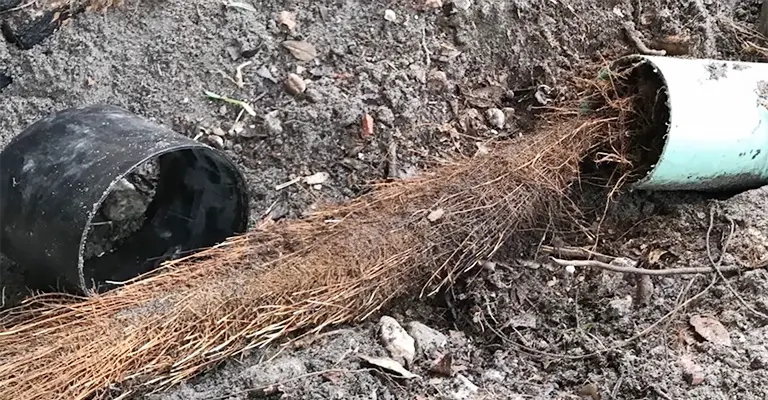
In trees, deep roots are attracted to areas with ideal growing conditions – moisture, nutrients, and oxygen. All those elements are present when a crack exists in a pipe if waste is also leaking, so roots can penetrate quickly.
In contrast, roots find it much more difficult to penetrate through an intact pipe. The length of time it takes for roots to penetrate your pipe depends on the type of tree root and the availability of food and moisture in your yard.
It is not unusual for them to grow into your pipes in as little as thirty days. When soil shifts, your pipes crack, which exposes them to root encroachment. Further, how fast it takes depends on the soil, erosion, and food source that the tree roots can access.
The time it takes roots to penetrate pipe walls after entering a connection is personal, but on average, roots can take as long as two years.
Those pipes that are older or made from lesser-durable materials like clay are more likely to crack and allow roots to penetrate them. Furthermore, shorter pipes may be more prone to root issues because they have more connections.
It is possible that homeowners who frequently use drain cleaning chemicals can weaken their pipes, making them more susceptible to cracking and allowing roots to grow inside them. Check out the explanation below to find out what all of this means.
What Are Drain Pipes?
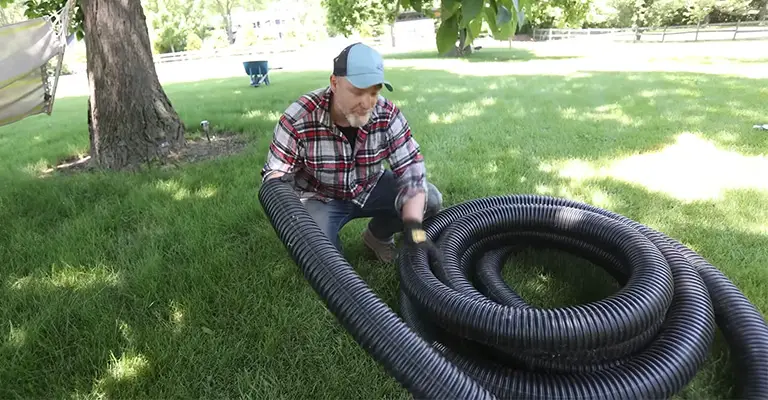
Drain pipes will transfer your waste from your home to the city’s sewer system. Your plumbing system, as well as any gutter runoff, is included in this list.
We’ll examine how fast tree roots can invade your sewer system and why they can interfere with your drain pipes next.
How Do Tree Roots Get Into My Pipes?
The two most common reasons tree roots grow in sewer pipes are moisture and food. Roots of trees are attracted to drain pipes because they have a variety of food sources.
Your drain pipes may be clogged with tree roots if soil erodes, the ground shifts or pipes begin to brittle. The damage to drain pipes occurs when tree roots penetrate them.
What Causes Tree Roots To Grow In Sewer Lines?
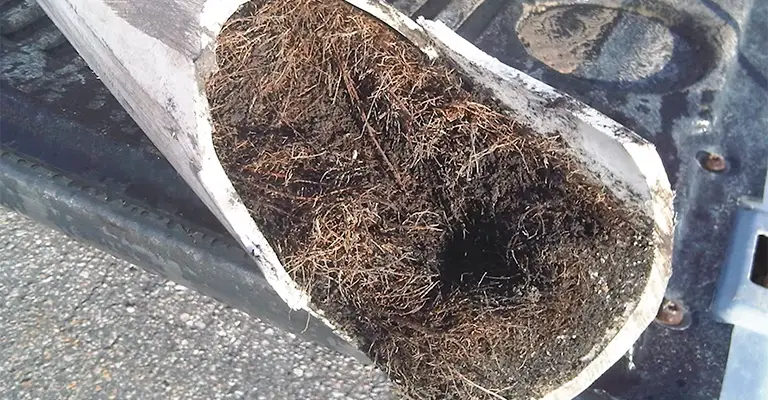
Water is the most important factor for tree roots. It is not uncommon for them to migrate to a sewer line after detecting underground moisture caused by a little leak, such as a plug in a toilet, and then force their way inside.
Tree roots can grow very quickly if the type of tree, the size of the pipe opening, and the amount of moisture present are all favorable. These roots grow in the sewer line because of the nutrients, oxygen, and water.
If not detected and solved, this can result in a blockage in the water flowing into your home, have detrimental effects on your health, and cost considerable amounts of money to repair.
Signs Of Tree Roots In Sewer Pipes
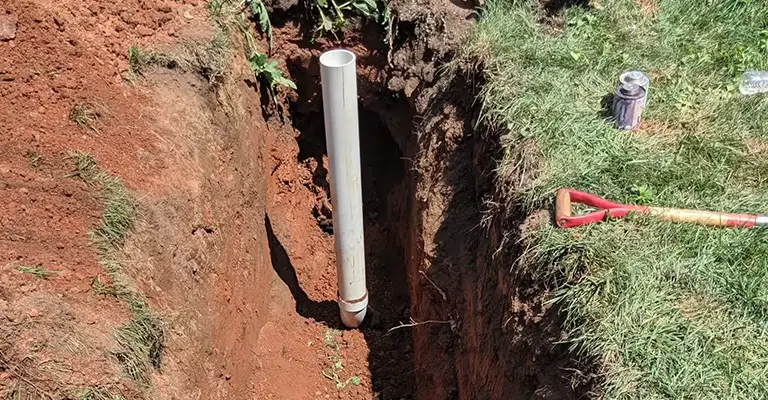
Some signs of tree roots in sewer lines can alert you to a potential problem. To determine if you should call a plumber or attempt to fix the problem on your own, you need to know these signs:
- Trees growing very fast and are greener than the others.
- Sewer backups
- Sinkholes in the yard
- Slow drains on a frequent basis
- Bad odors
- Collapsed and blocked pipes
The presence of such roots in your line indicates that you may have tree roots. Several trees, including Oak, Ash, Willow, Elm, Tulip Tree, Walnut, and Poplar, are notorious for infiltrating sewer lines.
If you possess any of these symptoms or trees, the best thing you can do is start taking preventative measures. After trying those, you must call a plumber to investigate the problem.
Consequences Of Tree Roots In Pipes
Tree roots in pipes left unnoticed and untreated will continue progressing until the symptoms worsen. You may often experience slow drainage, foul odors, and clogged drains and toilets.
Putting off evaluating the problem can increase your chances of needing a complete sewer line replacement.
How Do You Get Rid Of Roots In A Sewer Line?
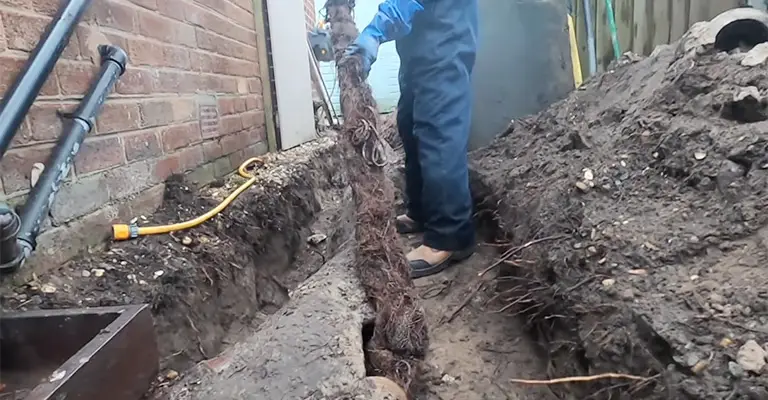
It’s not impossible to get tree roots out of sewer lines, but you need to know how. In most cases, consumers rush to the hardware store and get whatever they can over the counter.
This has the disadvantage of you not knowing what happens underneath. You might not realize that the root system of your trees is causing a more serious problem than you think when you consider quick fixes.
Professional plumbers can determine the extent of the damage only by arriving on the scene to assess it. Using a small sewer line camera, a plumber can assess the problem based on your symptoms.
Including those trees in your neighbor’s yard that may be connected to your neighbor’s roots is considered by them.
Your plumber may recommend trenchless sewer line replacement if you have tree roots in your line. This quick and easy repair won’t completely rip up your yard.
What Do I Do When a Tree Roots in A Sewer Pipe?
Despite what you may think, there are a few simple home remedies that can assist you in keeping roots out of your drain pipes. The following are some options you can consider:
This mechanical equipment is inserted into the piping system and sent to the obstruction through the rooter or auger. In addition to slicing up the roots, the auger flushes the pipes after the obstruction is located.
Wastewater is used to wash away any debris left behind. Hydro jetting thrusts water through the pipes with a pressure of 4,000 pounds per square inch. A water pressure of this magnitude can destroy roots.
The toilet farthest from the road should be covered with rock salt (Sodium Chloride). If you want to remove the salt from your toilet, flush it with a bucket of water after adding a handful of salt to the tank.
Wait until the next afternoon before flushing the toilets. Because roots grow back, the salt will only be a temporary fix since it will dry out the roots.
Using copper sulfate, you can kill any root system in your pipes. You only need a half cup of these blue crystals to get started. Copper sulfate can be purchased at most hardware stores and is a natural herbicide.
In some cases, it may be possible to repair the drainage system by cutting out the existing piping layout, although it is not the best option.
There will still be a way for tree roots to reach sewer pipes even as they grow. The best option here would be to cut out the old pipes and replace them during root removal. Taking the time to fix this is more difficult due to the cost of materials.
How Much Does It Cost?
There is never much excitement associated with removing tree roots from drain pipes. In many cases, homeowners do not even consider this possibility since trees are planted for various aesthetic reasons and curb appeal.
Planting certain trees can be risky with their aggressive root systems, so drain pipes should be kept clear of them.
An inspection with a sewer scope is likely to be required, and these can cost up to $200. If you are planning to have your home inspected, you can also get this service included at a discounted rate.
Depending on your contractor, you can expect to pay anywhere from $100 to $600 for tree root removal. Additionally, the plumbing contractor will likely have to dig up and replace the drain pipeline, adding to the cost.
Each additional foot typically costs $250. Take a look at what it would cost for you to dig and replace 6 feet of tree roots, and it will cost you $1,500, so make sure you consider all your options and quotes.
Prevent Tree Roots in Your Pipes
Trees that grow slowly or sewer-safe trees can be planted to prevent the problems before they happen.
A professional inspection and cleaning of your lines every year is also a suitable prevention method since they know what to look for and can detect potential problems before they become a problem.
Other Recommended Maintenance
It is not uncommon for older homes to have plumbing problems when you are looking to buy one. Because the pipes often they are composed of lead, galvanized, or polybutylene.
Unfortunately, each one has issues and will need to be replaced, which will be very expensive.
In addition, you may have to add this expense to the home’s price. If you are having trouble, you can do a few things to make hot water last longer in your home.
There are many causes of water heater failure besides the thermostat, such as broken parts in the water heater, the water heater being old, sediment, or multiple appliances running simultaneously.
Determining what is causing the problem can save money in the long run. The last thing you should consider when thinking about safety in the home is to test for radon if you haven’t in the previous two years.
Depending on where you live, some areas of the U.S. have higher levels of radon, an odorless gas that threatens health.
It is important to consider different types of tests if you live in an area with high occurrence rates or are planning to purchase a house.
When Do I Call A Professional?
Tree roots encroaching on your drain pipes should be addressed by a professional as soon as possible.
The damage to the plumbing system is usually more severe when homeowners attempt to unclog the drain pipes on their own.
Hire a licensed plumber to come out and assess the issue and provide you with the best solution. As an additional option, you can contact a company that conducts sewer scope inspections and schedule a full home inspection simultaneously.
Additionally, they might be able to recommend plumbing services that you might need, allowing you to combine your two projects.
Conclusion
You might find tree roots in your underground plumbing if you’re not careful.
In the same way that other projects are neglected, items that are out of sight and out of mind are too often ignored.
Preventive maintenance tools such as rock salts or copper sulfate can also help prevent tree roots from getting into drain pipes.






